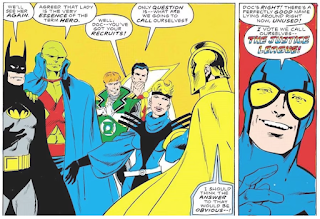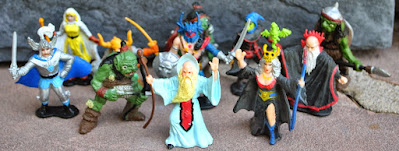I'm going to define magitech for my purposes here as technology (in the sense of items that appear industrial, mechanical, or electronic) that is powered by magic. I tend to like magitech when it is done well, but I find it often isn't done well, in my judgement. I've spent some time thinking about what for me constitutes "doing it well" versus not.
There are, I think, different types of magitech in media, and the one that almost always works for me is what I would call naive. Naive magitech occurs when the portrayal of something mythic, fairytale-like (and I think those are the two most common modes) just happens to feature some trappings of technology. Stories with naive magitech give the impression the technology they feature is just assumed in the same way Medieval or early modern tech is just assumed in traditional fairytales. Baum's Oz includes elements of this, but so do the New Gods related series from Kirby, or other works of later creators working in a Kirby mode.
I revisited the Blackstar (1981) cartoon series not too long ago, and it has a great example in the episode "Lightning City of the Clouds." Crios the Ice-King is trying to stop Spring from coming to the Planet Sagar, keeping the planet in eternal winter. He attempts to steal the key to springtime with his fortress that flies on a cloud and appears to be made of ice. That fortress also has a futuristic-appearing control room (draped with icicles) complete with a video screen where he can talk to his boss, Overlord.
It's a setting that makes no attempt separate science fiction and fantasy. We might well call it science fantasy, though that term also covers works that include things clearly defined diegetically as scientific, but are utterly implausible. What I'm interest in here is fantastic technology that is understood within the story as magical or at least implicitly such.
Other examples of magitech, what is more traditional meant by that term, occur when magic is used to replicate something close to modern or science fictional technology. Unlike the naive magitech, it is often part of a rationalized or systemized portrayal of magic, but not necessarily. It's this sort of magitech that can often go wrong because it ends up with obvious cliches (magic carpet taxis, magic wands for guns) or the Rube Goldbergian devices on Flintstones or Gilligan's Island where it becomes a joke based around, "just how are they gonna build this device?"
I find both of these approaches unsatisfying because not only are they often silly (intentionally or unintentionally) but because they make the fantastic mundane.
I think good magitech ought to aim to do the opposite: make the mundane fantastic.
How does that work? Well, I think magitech should general not be identical to a scientific technical solution to the problem. There ought to be new (and interesting) complications and implications. I'll give a couple of examples: In the comic book series The Outer Darkness, the starship is powered by a captive god who demands sacrifice. This has all sorts of implications for how one might coax more power from the engines or what an engine breakdown looks like. A containment breach becomes a whole different sort of danger.
In my Weird Adventures setting there are radio para-elementals. Their existence suggests something about the physics of the setting, making it more aligned with fantasy, but also brings up interesting complications for radio operation.
There are lots of other examples, but you get the idea. In summary, I guess my pitch is: if you are going to include magitech, think about what it implies about how the world is different from the one we know. That doesn't mean you need a rigorously worked out "magic system." It just means putting though into how technology and the world it exists in are of a piece.








































